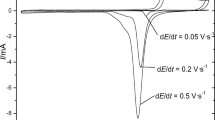Abstract
Cobalt and copper hexacyanoferrate films (CoHCF and CuHCF) were formed at carbon film electrodes by three different one-step processes: cycling the applied potential, application of a constant current, and chemically. All hexacyanoferrate films obtained were characterized electrochemically by cyclic voltammetry and electrochemical impedance spectroscopy. To evaluate their possible use as redox mediators for biosensors, they were applied to the determination of hydrogen peroxide in neutral phosphate buffer saline electrolyte. Chemically deposited CuHCF was found to be generally the most suitable as a mediator, although CoHCF made by potential cycling is the most useful when a very low detection limit is necessary.








Similar content being viewed by others

References
Koncki R (2002) Crit Rev Anal Chem 32:79
Karyakin AA (2001) Electroanalysis 13:813
de Tacconi RN, Rajeshwar K, Lezna RO (2003) Chem Mater 15:3046
Horányi G, Inzelt G, Kulesza PJ (1990) Electrochim Acta 35:811
Kulesza PJ, Galus Z (1992) J Electroanal Chem 323:261
Kulesza PJ, Malik MA, Miecznikowski K, Wolkiewicz A, Zamponi S, Berrettoni M, Marassi R (1996) J Electrochem Soc 143:L10
Malik MA, Horányi G, Kulesza PJ, Inzelt G,Kertész V, Schmidt R, Czirok E (1998) J Electroanal Chem 452:57
Kulesza PJ, Malik MA, Berrettoni M, Giogetti M, Zamponi S, Schmidt R, Marassi R (1998) J Phys Chem B 102:1870
Kulesza PJ, Malik MA, Schmidt R, Smolinska A, Miecznikowski K, Zamponi S, Czerwinski A, Berrettoni M, Marassi R (2000) J Electroanal Chem 487:57
Malik MA, Miecznikowski K, Kulesza PJ (2000) Electrochim Acta 45:3777
Cataldi TRI, Centonze D, Guerrieri (1995) Anal Chem 67:101
Cataldi TRI, Guascito R, Salvi AM (1996) J Electroanal Chem 417:83
Cataldi TRI, De Benedetto GE, Bianchini A (1998) J Electroanal Chem 448:111
De Benedetto GE, Guascito MR, Ciriello R, Cataldi TRI (2000) Anal Chim Acta 410:143
Cataldi TRI, De Benedetto G, Bianchini A (1999) J Electroanal Chem 471:42
Karyakin AA, Gitelmacher OV, Karyakina EE (1994) Anal Lett 27:2861
Karyakin AA, Karyakina EE, Gorton L (1996) Talanta 43:1597
Chi QJ, Dong SJ (1995) Anal Chim Acta 310:429
Moscone D, D’Ottavi D, Compagnone D, Palleschi G, Amine A (2001) Anal Chem 73:2529
O’Halloran MP, Pravda M, Guilbault GG (2001) Talanta 55:605
Garjonyte R, Malinauskas A (1999) Sens Actuat B 56:93
Wang J, Zhang XJ, Prakash M (1999) Anal Chim Acta 395:11
Mattos IL, Gorton L, Laurell T, Malinauskas A, Karyakin AA (2000) Talanta 52:791
Lin MS, Wu YC, Jan BI (1999) Biotechnol Bioeng 62:56
Chen SM (2002) J Electroanal Chem 521:29
Eftekhari A (2003) Microchim Acta 141:15
Florescu M, Brett CMA (2004) Anal Lett 37:871
Cai CX, Xue KH, Zhou YM, Yang H (1997) Talanta 44:339
Milardović S, Kruhak I, Iveković D, Rumenjak V, Tkalčec M, Grabarić BS (1997) Anal Chim Acta 350:91
de Mattos IL, Gorton L (2001) Quim Nova 24:200
Chen S-M, Peng K-T (2003) J Electroanal Chem 547:179
Shankaran DR, Narayanan SS (2002) Sens Actuat B 86:180
Shankaran DR, Narayanan SS (1999) Fresen J Anal Chem 364:686
Brett CMA, Angnes L, Liess HD (2001) Electroanalysis 13:765
Filipe OMS, Brett CMA (2003) Talanta 61:643
Florescu M, Brett CMA (2005) Talanta 65:306
Filipe OMS, Brett CMA (2004) Electroanalysis 16:994
Joseph J, Gomathi H, Rao GP (1991) J Electroanal Chem 304:263
Chen SM, Chan CM (2003) J Electroanal Chem 543:161
Shankaran DR, Narayanan SS (1999) Fresen J Anal Chem 364:686
Lezna RO, Romangnoli R, de Tacconi NR, Rajeshwar K (2002) J Phys Chem B 106:3612
Antunes RMM, Sequeira CAC (2004) Ciênc Tecnol Mater (in Portuguese) 16:66
Makowski O, Stroka J, Kulesza PJ, Malik MA, Galus Z (2002) J Electroanal Chem 532:157
Kahlert H, Retter U, Lohse H, Siegler K, Scholz F (1998) J Phys Chem B 102:8757
Cardoso WS, Francisco MSP, Lucho AMS, Glushikem Y(2004) Solid State Ionics 167:165
Karyakin AA, Karyakina EE, Gorton L (1999) Electrochem Commun 1:78
Malinauskas A, Araminaitė R, Mickevičiūté G, Garjonytė R (2004) Mat Sci Eng C 24:513
Dostal A, Hermes M, Scholz F (1996) J Electroanal Chem 415:133
Mo JW, Ogorevc B, Zhang X, Pihlar B (2000) Electroanalysis 12:48
Acknowledgements
Financial support from Fundação para a Ciência e Tecnologia (FCT) Portugal, ICEMS (Research Unit 103), and European Project HPRN-CT-2002-00186 is gratefully acknowledged. R Pauliukaite thanks FCT for a postdoctoral fellowship (SFRH/BPD/14518/2003). Prof. H.-D. Liess is thanked for the gift of the electrical resistors.
Author information
Authors and Affiliations
Corresponding author
Additional information
Dedicated to Professor George Horanyi on the occasion of his 70th birthday, in recognition of his outstanding contributions to electrochemistry.
Rights and permissions
About this article
Cite this article
Pauliukaite, R., Florescu, M. & Brett, C.M.A. Characterization of cobalt- and copper hexacyanoferrate-modified carbon film electrodes for redox-mediated biosensors. J Solid State Electrochem 9, 354–362 (2005). https://doi.org/10.1007/s10008-004-0632-8
Received:
Revised:
Accepted:
Published:
Issue Date:
DOI: https://doi.org/10.1007/s10008-004-0632-8



